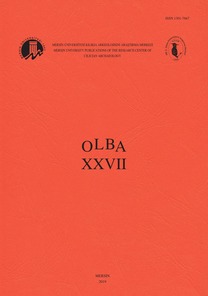Tarsuslu Nectarius’un İlk Constantinopolis Patriği Olarak Seçilmesi
İstanbul
The Election of Nectarius of Tarsus as the First Patriarch of Constantinople
Istanbul,
___
Baynes 1926 Baynes, N., “Alexandria and Constantinople: a Study in Ecclesiastical Diplomacy” Byzantine Studies and Other Essays, 97-115, Oxford. Bebis 1998 Bebis, G.S., “Patriarch”, E. Ferguson (ed.), Encyclopedia of Early Christianity, 879-880, New York & Londra. Chadwick 1979 Chadwick, H., “The Role of the Christian Bishop in Ancient Society” in Centre for Hermeneutical Studies, Protocol of the 35th Colloqium cilt 35, 1-14, Berkeley. Chadwick 2003 Chadwick, H., East and West, The Making of a Rift in the Church, From Apostolic Times Until the Council of Florence, Oxford. Dagron 1974 Dagron, G., Naissance d’une capitale, Constantinople et ses institutions de 330 à 451, Paris. Daley 1993 Daley, B. E., “Position and Patronage in the Early Church: the Original meaning of ‘Primacy of Honour’”, JTS 44/2, 529-553. De Ste. Croix 1954 De Ste. Croix, G.E.M., “Suffragius: From Vote to Patronage” The British Journal of Sociology 5/1, 33-48. Ensslin 1953 Ensslin, W., Die Religionspolitik des Kaisers Theodosius d. Gr., Münih. Errington 1997 Errington, R.M., “Church and State in the First Years of Theodosius I”, Chiron 27, 21-72. Geonakoplos 1989 Geonakoplos, D.J., “The Second Ecumenical Council at Constantinople (381): Proceedings and Theology of the Holy Spirit” Constantinople and the West. Essays on the Late Byzantine (Palaeologan) and Italian Renaissances and Byzantine and Roman Churches, 159-177, Madison & Londra. Giles 1952 Giles, E., Documents Illustrating Papal Authority A.D. 96-454, Londra. Gilliard 1988 Gilliard, F.D., “Senatorial Bishops in the Fourth Century” The Harvard Theological Review 77/2, 153-175. Haas 1997 Haas, C., Alexandria in Late Antiquity, Topography and Social Conflict, Baltimore. Hanson 1988 Hanson, R.P.C., The Search for the Christian Doctrine of God, Edinburgh. Jones 1986 Jones, A.H.M., The Later Roman Empire, Maryland. Jonkers 1954 Jonkers, E.J., Acta Et Symbola Conciliorum Quae Saeculo Quarto Habita Sunt, Textus Minores vol. XIX, Leiden. Kaçar 2003 Kaçar, T., “Ioannes Chrysostomus’un Düşüşü: Doğu Roma Başkentinde Din ve Politika” Belleten LXVII/250, 745-70. King 1961 King, N.Q., The Emperor Theodosius and the Establishment of Christianity, Londra. Kolb 2001 Kolb, F., Herrscherideologie in der Spätantike, Berlin. Lepin 2003 Lepin, H., Theodosius der Grosse: auf dem Weg zum christlichen Imperium, Darmstadt. Liebeschuetz 1984 Liebeschuetz, W., “Friends and Enemies of Johm Chrysostom” Maistor: Classical, Byzantine and Renaissance Studies for Robert Browning, ed. by Ann Moffatt, Byzantina Australiensa 4, 85-111, Canberra. Mclynn 1994 Mclynn, N., Ambrose of Milan: Church and Court in a Christian Capital, Berkeley. Mossay 1977 Mossay, J., “Gregor von Nazianz in Konstantinopel (379-381 A.D.)”, Byzantion 47, 223-238. Norton 2007 Norton, P., Episcopal Elections 250-600, Hierarchy and Popular Will in Late Antiquity, Oxford. Ritter 1965 Ritter, A.M., Das Konzil von Konstantinopel und Sein Symbol, Studien zur Geschichte und Theologie des II. Ökumenischen Konzils, Göttingen. Saller 1982 Saller, R., Personal Patronage in the Early Empire, Cambridge. Tanner 1990 Tanner, N., Decrees of the Ecumenical Councils Volume one Nicaea I to Lateran V, Washington. Wallace-Hadrill 1989 Wallace-Hadrill, A., (ed.) Patronage in Ancient Society, Londra.- ISSN: 1301-7667
- Yayın Aralığı: 1
- Başlangıç: 1998
- Yayıncı: Kilikia Arkeolojisini Araştırma Merkezi
KILIKYA’DA GEÇ ANTİK DÖNEM KIRSAL YERLEŞİMLERİ: KANYTELLIS ÖRNEĞİ
ALAHAN'DA (ISAURYA) BİR ROMA KENTİNİN KEŞFİ
Hugh ELTON, Mark JACKSON, Gabriele MIETKE, James NEWHARD, Lale ÖZGENEL, Emma TWİGGER
Tarsuslu Nectarius’un İlk Constantinopolis Patriği Olarak Seçilmesi
Roma Döneminden Bizans Dönemine Kilikia’da Seramik Üretimi. Elaiussa Sebaste’den Yeni Veriler
Adele Federica FERRAZZOLI, Marco RICCI
Dağlık Kilikia’da Lamos: Bir Mimari Yüzey Araştırması
Rhys F. TOWNSEND, Michael C. HOFF
Tarsus Episkoposu Akakios: Ariusçu Belirtileri Ayırt Etmek
Cilician Ceramic Production From Roman to Byzantine Age. New Data From Elaiussa Sebaste
Adele Federica FERRAZZOLI, Marco RICCI
Antike Autoren über Kilikien. Überlegungen am Beispiel der Stadt Tarsos
Ein neuer Kultvorschlag für den Tempel in Elaiussa Sebaste (Kilikien)
